More about Nymphs and Satyrs (A Tribute to Pomona – Allegory of Fertility)

Sr. Contributor
It is fitting that Jordaens would create more than one version of a painting about abundance.
In fact, Jordaens’ 1623 painting about the Goddess Pomona is titled Allegory of Abundance, which is not to be confused with the alternate title to this 1616 painting, Allegory of Fruitfulness. He may not have been very creative with his titles or his subject matter, but the man sure could paint a naked party scene.
Homage to Pomona is all about the booty, and I’m not just talking about those adorable cherub butts. In Roman mythology Pomona is the Goddess of fruitful abundance who watches over and prunes the fruit orchards. According to Ovid, Pomona was “supple and robust” (aka, hot) and had the demi-gods Silvanus and Picus (the son Saturn didn’t eat) drooling over her and her “fruit.” Despite many attempts to seduce her, the two men were outwitted by a man named Vertumnus who, in true Roman fashion, tricked the wood nymph into making out with him.
The story goes that Vertumnus told Pomona he was into her but she still wouldn’t "let him into her garden." Rather than give up, Vertumnus dressed up as a series of different types of men in hopes that she’d let one of them prune her hedges. After several failed attempts it occurred to him that the masculine art of seduction wasn’t working and perhaps he should turn to the feminine art of guilt and fear. Dressed as an old woman he got through her gate and proceeded to chase her around the orchard kissing her (you’d think this would have tipped Pomona off). Once he was done being a sexual predator, Vertumnus employed the weapon of mothers around the world and told Pomona that she wouldn’t be young forever and had better settle down and start having babies lest she grow old alone like Aunt Doris and her cats. How about that Vertumnus? He seemed like a nice young fellow. And so handsome! At this point his disguise fell off, Pomona shrugged, said “why not,” and agreed to marry him.
One assumes that this scene takes place after Pomona and Vertumnus marry because naked ladies, angry satyrs, and hungry tigers don’t seem like the company a virginal nymph would keep.

Contributor
Pomona is the Roman goddess of fruitful abundance.
Her superpower is the ability to make fruit trees fruitful, and her sacred tool is the pruning knife.
Pomona's half woman/half goat assistant is stealing fruit from the underage child laborers in the lower left side of the painting, but Pomona does not care. She has the pruning knife.
Also, she has not made up her mind if she wants to be dressed or not, so she has opted to casually drape a curtain around her left thigh. This idea never really caught on because it is impractical.













